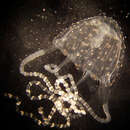en
names in breadcrumbs


Carukia barnesi is in the Class Cubozoa, Order Carybdeida, and Family Carybdeidae. Carukia barnesi was named after Dr. Jack Barnes who was searching for the jellyfish who caused the Irukandji syndrome. He had confirmed that the jellyfish he found did cause Irukandji syndrome by stinging himself, his son, and a surf life saver, sending them all to the hospital, in 1964. It was Hugo Flecker, however, that had named the overall syndrome caused by this jellyfish, the Irukandji syndrome.
Carukia barnesi have image-forming eyes that respond to images, but have no brain to process the visual information.
Perception Channels: visual
Carukia barnesi has not been given special conservation status.
US Federal List: no special status
CITES: no special status
State of Michigan List: no special status
Cubozoans have a two-stage life cycle consisting of a medusa and polyp. Fertilized eggs develop into swimming planulae, which settle after a few days. The planulae develop into motile feeding polyps, which produce other budding polyps. Polyps take a few months to mature, then begin metamorphosis by resorbing tentacles. Four new tentacles and four rhopalia are formed. When the single juvenile medusa has fully metamorphosed, it contracts and swims away.
Usually about 30 minutes after a person is stung by C. barnesi the victim begins to experience the following symptoms: a severe back or headache, shooting pain throughout the muscles in their chest and abdomen, nausea, anxiety, restlessness, and sometimes vomiting. Occasionally fluid may fill the lungs, which if not treated could be fatal. These symptoms can last from hours to days and requires hospitalization. No conclusive information has been obtained regarding the contents of the venom, but it might contain a neurotoxin that is a neural Na+ channel activator. No antivenom has yet been developed for this species.
Negative Impacts: injures humans (bites or stings, venomous )
There is no known human benefit from this species except that it serves to be an interesting research specimen because of the symptoms it causes when a person is stung.
Positive Impacts: research and education
The role of Carukia barnesi in its ecosystem is currently not known.
As C. barnesi matures, its diet switches from invertebrates to vertebrates. Box jellyfish in general utilize a toxin to paralyze their prey. The toxin is injected into the prey by the prey triggering one of the stinging cells (nematocysts) on the jellyfish’s tentacle. Once the stinging cell is triggered, a harpoon looking coil is released which stings the prey and the toxin then flows through this hollow harpoon into the prey. The tentacle can then be retracted back into the jellyfish, bringing the prey with it towards the jellyfish’s mouth, which is located inside the bell.
Animal Foods: fish; other marine invertebrates
Primary Diet: carnivore (Piscivore , Insectivore , Eats non-insect arthropods, Eats other marine invertebrates)
Carukia barnesi can be found along the coastline of Northern Australia, from Broome along the western side of Australia to Rockhamptom, Queensland on the eastern side. This includes Port Douglas in North Queensland to the Whisunday Islands near Mackay. It is also found in the Cairns regions and the Great Barrier Reef.
Biogeographic Regions: australian (Native )
Carukia barnesi, unlike its congener Chironex fleckeri, is typically found in deeper waters along reefs.
Range depth: near surface to 10-20 m.
Habitat Regions: saltwater or marine
Aquatic Biomes: reef ; coastal
At this time the lifespan of Carukia barnesi is not known.
The Irukandji jellyfish is a carybdeid cubazoan, which tend to be smaller than the other type of cubozoa, the chirodropids. Individuals of this species typically reach 25 mm in diameter, however it has been documented at a diameter of 35 mm. Carukia barnesi consists of a transparent bell that is cuboidal in shape that narrows slightly towards the apex. Extending from each of the four corners of the bell is a retractable tentacle that varies in length from 50 to 500 nm. Both the tentacles, as well as the body, are covered in stinging cells called nematocysts, however, the type of stinging cells differs on these two parts of the body. This box jelly also has a primitive and transparent eye on each side of its bell.
Range length: 20 to 35 mm.
Average length: 25 mm.
Other Physical Features: ectothermic ; radial symmetry ; polymorphic ; venomous
Irukandji jellyfish are small and colorless, making them difficult to find.
Anti-predator Adaptations: cryptic
The mating system of the Irukandji jellyfish has yet to be recorded, but in some cubazoan species the adults release both sperm and eggs into the ocean where fertilization will occur.
Mature females of Carukia barnesi are defined as having fully developed oocytes. This typically occurs when the bell height exceeds 8 mm. Males are considered mature when bell height is comparable to that of mature females.
Key Reproductive Features: sexual ; fertilization (External )
At this time there is no known parental care.
Parental Investment: no parental involvement